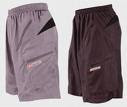 Mountain biking is more commonly done during summer. But if you feel like riding during the cold season where everyone is hibernating in their homes, you are free to do so. But just like any other winter activities, certain preparation is necessary to ensure the safety of every member of your team.
Mountain biking is more commonly done during summer. But if you feel like riding during the cold season where everyone is hibernating in their homes, you are free to do so. But just like any other winter activities, certain preparation is necessary to ensure the safety of every member of your team.I said "team" because I don't recommend you, conquering any trail alone. You must have at least one riding companion. The following are the general ways to prepare for your winter biking adventure:
 Be physically fit
Be physically fitOne of the better ways to stay safe while on the trail is to prepare for it physically. Design a training plan that includes weight training to develop strength and cardio activities to improve your endurance. Do it at least 3 times a week for one or two months before your scheduled trip. I recommend that you train with your group members. Avoid alcohol and smoking. Get enough sleep and rest.
Moreover, mountain biking skill and physical fitness vary so before setting out, know each member's strengths and weakness. Never try anything that is beyond the ability of the weakest person. Stick together as a group. Do not allow any member to be left behind and go ahead of the main party.
 Plan
PlanKnow the trail. The worst thing that can happen to you out there is to be on an accident. Once you have identified where you want to ride your bike, do your homework. Get a map of the trail at least a week before your actual trip and know where sharp curves, steep descends, and dangerous areas are.

Get the weather report.
Winter season can have unpredictable weather patterns - especially on high altitude areas. Get an extended forecast. Do not forget to check with authorities. Forrest rangers know their areas very well. They carry important information about the trail, the condition of the place and the possible problems that may occur so you may prepare for it.
 Bring the necessary equipment
Bring the necessary equipmentThe items you should bring depend on the condition of the trail and the proximity of the trail from your home. But there are things that are mandatory to bring: sufficient food and water, puncture kit (spare inner tube, pump, patches and glue), basic tool kit for bike repair, flashlights, and first aid kit. You should also carry an identification and medical info, map, compass (GPS if you have one), money, bike headlight, matches, whistle, and cellular phone or satellite phone.
 Wear proper clothes
Wear proper clothesWhether you are planning to stay overnight on the trail or go back to your home at the end of the day, never take clothes for granted. Wear jacket or windbreaker that is suited for the temperature. Clothes that are compact, lightweight and can resist freezing temperature should be in your backpack. Keep your toes and fingers well-insulated. An outdoor blanket is a must if you are going out for days.
 Let your family or friends know where you are
Let your family or friends know where you areList your itineraries and give it you your family or friends who will be left behind. List down each member's name, addresses and contact persons in case of emergency, license plate of the vehicle you are using (if there is any), and expected time of return.
 Have fun and be safe!
Have fun and be safe!








